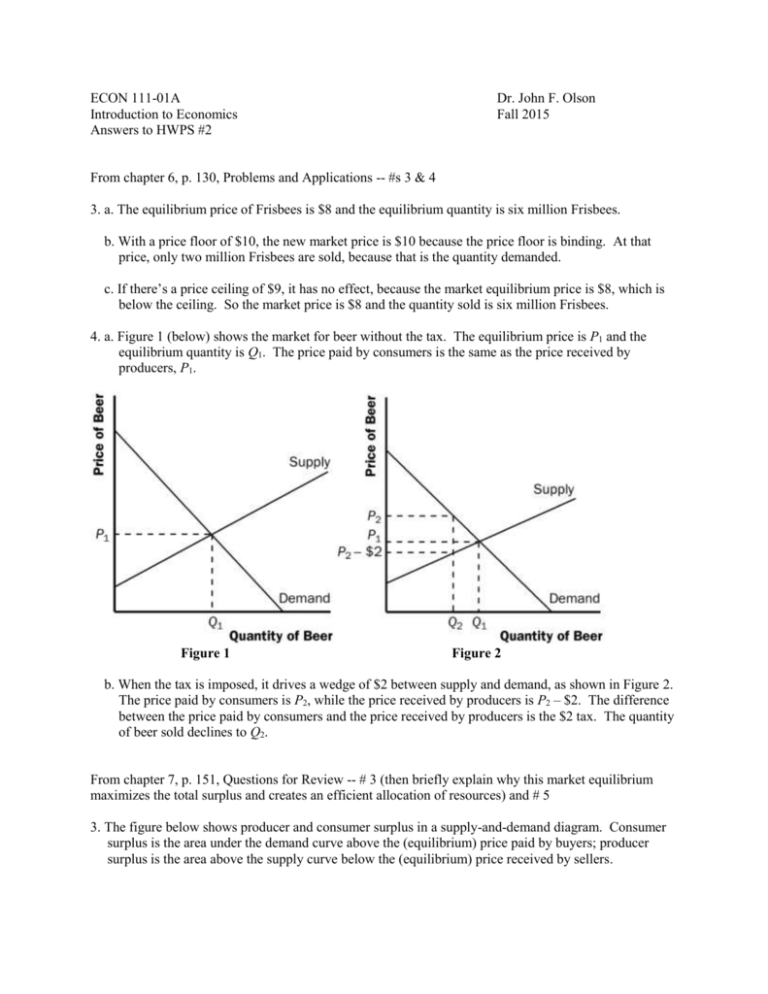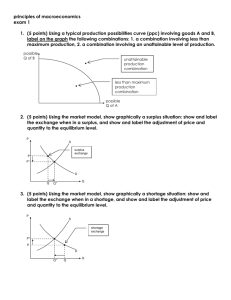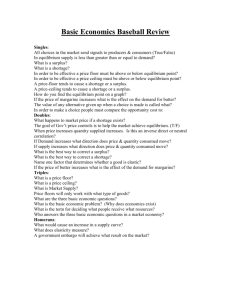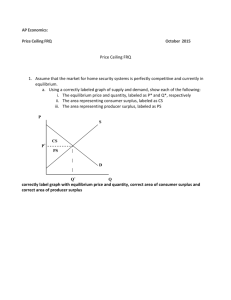HWPS#2
advertisement

ECON 111-01A Introduction to Economics Answers to HWPS #2 Dr. John F. Olson Fall 2015 From chapter 6, p. 130, Problems and Applications -- #s 3 & 4 3. a. The equilibrium price of Frisbees is $8 and the equilibrium quantity is six million Frisbees. b. With a price floor of $10, the new market price is $10 because the price floor is binding. At that price, only two million Frisbees are sold, because that is the quantity demanded. c. If there’s a price ceiling of $9, it has no effect, because the market equilibrium price is $8, which is below the ceiling. So the market price is $8 and the quantity sold is six million Frisbees. 4. a. Figure 1 (below) shows the market for beer without the tax. The equilibrium price is P1 and the equilibrium quantity is Q1. The price paid by consumers is the same as the price received by producers, P1. Figure 1 Figure 2 b. When the tax is imposed, it drives a wedge of $2 between supply and demand, as shown in Figure 2. The price paid by consumers is P2, while the price received by producers is P2 – $2. The difference between the price paid by consumers and the price received by producers is the $2 tax. The quantity of beer sold declines to Q2. From chapter 7, p. 151, Questions for Review -- # 3 (then briefly explain why this market equilibrium maximizes the total surplus and creates an efficient allocation of resources) and # 5 3. The figure below shows producer and consumer surplus in a supply-and-demand diagram. Consumer surplus is the area under the demand curve above the (equilibrium) price paid by buyers; producer surplus is the area above the supply curve below the (equilibrium) price received by sellers. The total surplus (the sum of consumer and producer surplus) is maximized at equilibrium because any smaller or larger quantity in the market reduces the total surplus. By maximizing the total surplus, the equilibrium quantity creates/achieves economic efficiency in that the buyers get the goods they want at the price they are willing to pay and that the sellers can provide/produce the goods at the lowest cost. 5. Two types of market failure are market power and externalities. Market power may cause market outcomes to be inefficient because firms may cause price and quantity to differ from the levels they would be under perfect competition, which keeps total surplus from being maximized. Externalities are side effects that are not taken into account by buyers and sellers. As a result, the free market does not maximize total surplus. From chapter 8, p. 169, Problems and Applications -- # 3 3. a. With very elastic supply and very inelastic demand, the burden of the tax on rubber bands will be borne largely by buyers. As the figure below on the left shows, consumer surplus declines considerably, by area A+B, but producer surplus decreases only by area C+D. b. With very inelastic supply and very elastic demand, the burden of the tax on rubber bands will be borne largely by sellers. As the figure below on the right shows, consumer surplus does not decline much, just by area A+B, while producer surplus falls substantially, by area C+D. Compared to part (a), producers bear much more of the burden of the tax and consumers bear much less.









